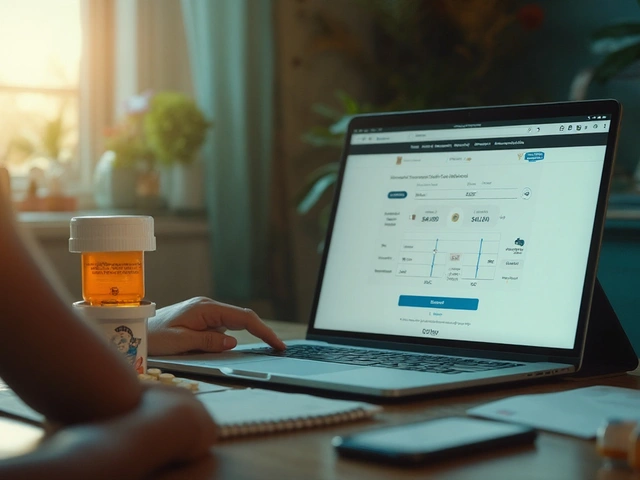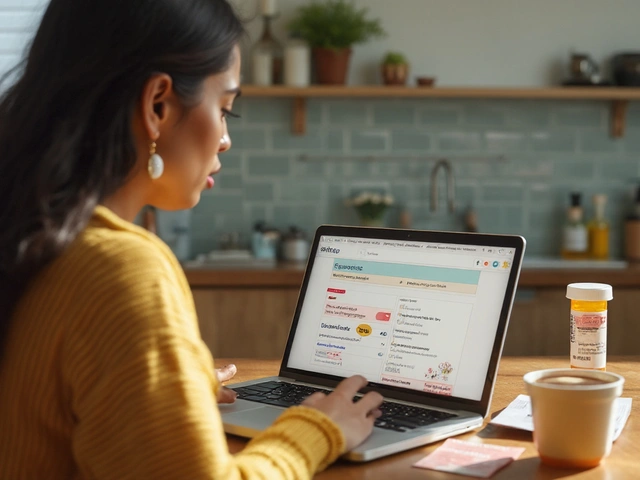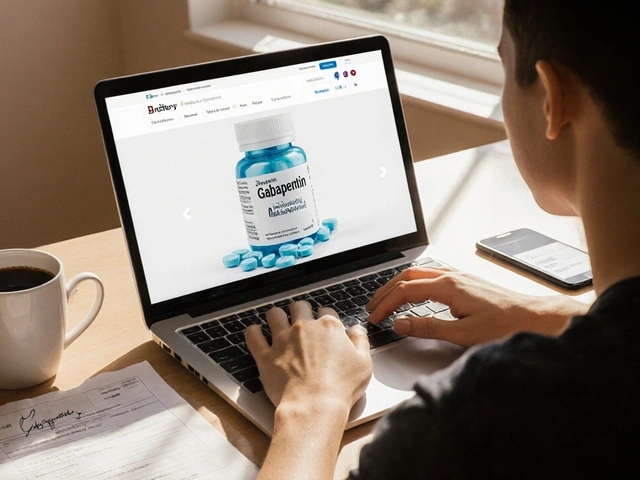
What Is Insulin Pump Therapy?
Insulin pump therapy is a way to deliver insulin continuously throughout the day and night, instead of using multiple daily injections. It’s a small, wearable device-about the size of a smartphone-that holds insulin in a reservoir and sends it through a thin tube (or wirelessly, in patch pumps) into your body. The insulin used is always a rapid-acting type, like insulin aspart or lispro, which works fast and clears quickly. This lets you match your insulin to your meals and activity more precisely than injections can.
Modern pumps don’t just drip insulin all day. Most now connect to a continuous glucose monitor (CGM), creating what’s called a hybrid closed-loop system. These systems automatically adjust your insulin based on your real-time blood sugar levels. For example, if your sugar starts dropping overnight, the pump can slow or stop insulin delivery to prevent a low. If your sugar rises after eating, it can give a small correction dose without you lifting a finger.
According to a 2022 study of over 25 clinical trials, people using insulin pumps had an average HbA1c of 8.3%, compared to 9.2% for those on injections. That 0.37% drop might sound small, but it’s the difference between a higher risk of nerve damage, eye problems, and kidney issues-and better long-term health.
Why People Choose Insulin Pumps
Many people with type 1 diabetes switch to pumps because they want more freedom. You don’t have to carry around syringes or find a bathroom to inject before every meal. You can eat when you’re hungry, not when your schedule says you should. Traveling, working out, or going out to dinner becomes easier because you can temporarily adjust your insulin needs with a few button presses.
One big reason is fewer nighttime lows. A 2022 analysis showed pump users had 32% fewer low blood sugar episodes while sleeping. That’s huge. Nighttime lows can be scary-and dangerous. Many users on Reddit say their overnight lows dropped from 3-4 times a week to once a month after switching to an automated pump like the Omnipod 5 or Medtronic 780G.
Quality of life improvements are real. In a survey of over 22,000 pump users, 82% said their life got better. Seventy-six percent liked the flexibility with meals. Sixty-eight percent noticed fewer lows. For parents of kids with type 1 diabetes, pumps mean less stress at night. You don’t have to wake up every hour to check sugar or give a snack.
The Downsides: What No One Tells You
Insulin pumps aren’t magic. They come with real challenges.
First, if the pump stops working-because the tubing kinks, the site gets clogged, or the battery dies-you’re at risk for diabetic ketoacidosis (DKA) within just 4 to 6 hours. That’s serious. One user on TuDiabetes.org shared that their Medtronic pump failed during a family vacation. They ended up in the ER with DKA. Now, they always carry backup insulin pens.
Then there’s the maintenance. You have to change the infusion set every 2 to 3 days. That means sticking a tiny catheter under your skin, often on your belly, arm, or leg. About 45% of users report skin irritation or redness at the site. Some get infections. Others find the tubing gets caught on doors, chairs, or clothes.
Alarm fatigue is real. Pumps beep for low insulin, high glucose, blocked lines, or low battery. One survey found 38% of users feel overwhelmed by the constant beeping. You learn to ignore some alarms-but that’s risky.
And yes, it’s expensive. The pump itself costs $5,000 to $7,000. Supplies-infusion sets, reservoirs, sensors-run another $3,000 to $5,000 a year. Insurance covers about 90% of U.S. patients, but you still pay $100 to $500 out of pocket after your deductible. If your insurance denies coverage, you’re stuck.

Who Benefits Most From a Pump?
Not everyone needs or should use a pump. Experts from the American Diabetes Association and the Association of Diabetes Care & Education Specialists say pumps work best for people who:
- Have trouble hitting their HbA1c target (above 7.5%) with injections
- Get frequent low blood sugars, especially at night
- Have hypoglycemia unawareness (don’t feel when their sugar drops)
- Have high glucose swings-spiking after meals, crashing by mid-afternoon
- Want more flexibility with meals, sleep, or exercise
They’re especially helpful for kids. A 2021 study showed children who started on pumps early had better long-term control. The FDA now approves pumps for kids as young as 2. In fact, 45% of U.S. children with type 1 diabetes use pumps, compared to 34% of adults.
But if you’re not comfortable with technology, struggle with math (calculating carb ratios or correction doses), or have anxiety around devices, a pump might make things harder. Dr. Anne Peters warns that people with eating disorders or tech anxiety often struggle to stick with it.
How to Get Started
Switching to a pump isn’t a quick decision. It takes planning, education, and patience.
First, talk to your diabetes care team. They’ll check if you’re a good candidate. You’ll need to show you can:
- Check your blood sugar at least 4 to 6 times a day (or use a CGM)
- Understand how insulin works with food and activity
- Calculate insulin doses based on carbs and high blood sugar
- Handle basic troubleshooting-like clearing a blocked tube or replacing a site
Most clinics require 3 to 5 training sessions over 2 to 4 weeks. You’ll learn how to program basal rates, set up boluses, respond to alarms, and manage sick days. About 70% of new users take 2 to 3 weeks to feel comfortable.
Common mistakes new users make:
- Putting the infusion set in the same spot every time (leads to scar tissue)
- Forgetting to bolus for snacks
- Not checking for kinks in the tubing after exercise
- Ignoring low battery warnings
Your care team will help you pick a pump. The three main types are:
- Tube-based pumps: Medtronic MiniMed 780G, Tandem t:slim X2. They have larger insulin tanks (up to 300 units) and more features, but you have tubing.
- Tubeless patch pumps: Insulet Omnipod 5. No tubing. Sticks directly to your skin. Waterproof up to 3 meters for 30 minutes. Holds 200 units. Popular for swimming, sports, and sleep.
Both types work with CGMs. The Omnipod 5 and Tandem t:slim X2 with Control-IQ are the most popular automated systems right now.

What to Expect in the First 30 Days
Week 1: You’ll be overwhelmed. You’ll forget to bolus. You’ll get alarms you don’t understand. You might feel frustrated. That’s normal.
Week 2: You’ll start to recognize patterns. You’ll notice your pump adjusts your basal rate better than you ever could with injections. You’ll stop panicking when the alarm goes off.
Week 3: You’ll start to feel like you’re in control. You’ll eat a slice of pizza at midnight and not stress. You’ll sleep through the night without checking your sugar. You’ll tell your partner, “I didn’t have to wake up once.”
Week 4: You’ll look back at your old injection routine and wonder how you ever managed. You’ll still have bad days-pump failures, site infections, stubborn highs-but you’ll know how to fix them faster.
Market Trends and What’s Coming
The insulin pump market is growing fast. In 2022, 38.4% of U.S. type 1 diabetes patients used pumps. That’s up from 28.6% in 2017. Experts predict 65% of new pediatric diagnoses will start on automated systems by 2027.
New tech is coming. Medtronic’s MiniMed 880G (expected late 2024) will extend its safety pause during lows from 90 to 150 minutes. Beta Bionics’ iLet Bionic Pancreas (in phase 3 trials) is designed to deliver both insulin and glucagon automatically-like a true artificial pancreas.
But adoption isn’t perfect. About 12% of users quit within two years. Reasons? Skin problems, alarm fatigue, or just feeling like the pump is more trouble than it’s worth. That’s why education and support matter more than the device itself.
Final Thoughts: Is It Right for You?
Insulin pump therapy isn’t about being better at diabetes. It’s about making diabetes less of a burden. If you’re tired of poking yourself five times a day, if you’re scared of nighttime lows, if you want to eat when you’re hungry instead of when your schedule says so-then a pump might be worth exploring.
But it’s not a cure. It’s a tool. And tools only help if you’re ready to use them. You still have to count carbs. You still have to check your numbers. You still have to change your site. You still have to carry backup insulin.
For many, the trade-off is worth it. The freedom, the sleep, the fewer lows, the better HbA1c-it adds up. But if you’re not ready for the responsibility, the cost, or the tech headaches, injections are still a perfectly valid, effective choice.
The goal isn’t to switch to a pump because it’s trendy. It’s to find the tool that helps you live your life-with less diabetes in the way.
Can children use insulin pumps?
Yes. FDA-approved insulin pumps can be used by children as young as 2 years old. Many pediatric endocrinologists recommend early adoption because pumps improve long-term blood sugar control and reduce nighttime lows. Parents often find them easier to manage than multiple daily injections, especially for toddlers and young children who can’t self-inject.
Do insulin pumps hurt?
The insertion of the infusion set feels like a quick pinch, similar to a needle stick. Most users say it’s less painful than multiple daily injections over time. The pump itself doesn’t hurt-it’s worn on a belt, in a pocket, or stuck to the skin. Some users experience soreness or irritation at the insertion site, especially if they don’t rotate locations. Using adhesive patches or skin barriers can help reduce discomfort.
Can I swim or shower with an insulin pump?
It depends on the pump. Tubeless patch pumps like the Omnipod 5 are waterproof up to 3 meters for 30 minutes, so swimming and showering are fine. Tube-based pumps like Medtronic or Tandem models are not waterproof-you must disconnect before swimming or bathing. Most users disconnect for 1 to 2 hours and use a temporary basal rate adjustment. Always check your pump’s manual for water resistance ratings.
What happens if my pump breaks?
You must have a backup plan. Always carry fast-acting insulin and syringes or pens. If your pump fails, switch to injections immediately. Don’t wait. DKA can develop within 4 to 6 hours without insulin. Most pump manufacturers offer loaner devices during repairs. Your diabetes care team should help you prepare for this scenario during training.
Will insurance cover an insulin pump?
In the U.S., 90% of patients get coverage through Medicare, Medicaid, or private insurance. But approval isn’t automatic. You’ll need documentation from your doctor showing you meet clinical criteria-like HbA1c above 7.5%, frequent lows, or hypoglycemia unawareness. If your claim is denied, you can appeal. Some manufacturers offer patient assistance programs if cost is a barrier.





Comments (8)
Chris Vere
The idea of replacing injections with a pump sounds like a dream until you realize how much responsibility comes with it. It's not just about technology-it's about discipline, awareness, and constant vigilance. I've seen people thrive with pumps and others burn out within months. The real metric isn't HbA1c-it's whether you're still living your life or just managing a machine.
Freedom isn't free. It's paid for in sleepless nights, alarm fatigue, and the quiet terror of a kinked tube at 3 AM. But for some, that cost is worth the silence of a peaceful night without a low.
Maybe the question isn't whether to use a pump. Maybe it's whether you're ready to let diabetes live inside your skin, not just under it.
Pravin Manani
From a clinical perspective, the hybrid closed-loop systems represent a paradigm shift in insulin delivery kinetics. The pharmacodynamic profile of rapid-acting analogs combined with real-time CGM-derived glucose telemetry enables dynamic basal rate titration with subcutaneous precision unattainable via MDI regimens. The 0.37% HbA1c reduction, while statistically significant, translates to a 15-20% reduction in microvascular event risk over a decade-a clinically meaningful endpoint.
However, the 12% discontinuation rate is a red flag. Non-adherence correlates strongly with cognitive load, particularly in populations with executive function deficits or comorbid anxiety disorders. The infusion set rotation protocol is often neglected, leading to lipohypertrophy and erratic absorption kinetics-this is underdiscussed in patient education modules.
Noah Fitzsimmons
Oh wow, so you mean this $7,000 glorified pager that beeps like a broken microwave is the future of diabetes care? Congrats, you traded needles for a $5000 anxiety machine. I bet the ER docs love it when someone shows up in DKA because they forgot to check for a kinked tube after doing jumping jacks.
And hey, let’s not forget the 38% who are so tired of alarms they’ve trained themselves to ignore them. That’s not innovation-that’s a death sentence with a warranty.
Clifford Temple
America’s healthcare system is broken, but at least we have this tech. In other countries, people are still using syringes from the 1920s. If you can’t afford a pump, you’re not trying hard enough. Get a second job. Sell your TV. This isn’t luxury-it’s survival. And if your insurance denies it, you’re just not fighting hard enough. We’ve got the best medicine in the world. Use it or get left behind.
Corra Hathaway
I switched to my Omnipod 5 last year and I’m crying happy tears 😭
My 8-year-old used to wake up screaming from lows at 2am. Now? She sleeps. I sleep. We both breathe. The beeps? Yeah, they’re annoying. But they’re the sound of safety. I used to dread bedtime. Now I just hug my pump and say ‘thank you’ before I turn off the light.
It’s not perfect. I’ve had site infections. I’ve panicked when it glitched. But I’d rather have a machine that bugs me than a disease that kills me. You’re not broken if you need this. You’re just smart.
Shawn Sakura
I been using a t:slim X2 for 18 months now and it changed my life. I used to be scared to eat pizza or go out to dinner. Now I just bolus and go. The only thing is, I still forget to check for kinks after working out. My care team says I need to be better about that. Also, I think I spelled basal wrong in my logs like 12 times. Sorry. But I’m alive and my A1c is 6.8. That’s something.
Paula Jane Butterfield
As a mom of a 5-year-old with T1D, I want to say: yes, pumps work for little ones. The insertion is a quick pinch-way less traumatic than five daily shots. And the best part? You can program a temporary basal to cover a birthday cake at a party without a single tear.
My daughter’s pump is her ‘buddy.’ She names it. She puts stickers on it. She tells it ‘good job’ when it gives a correction. It’s not just a device-it’s part of her routine, her safety net.
For parents: don’t wait until your child is ‘old enough.’ Early adoption = fewer lows, better brain development, less parental guilt. And yes, you’ll mess up. We all do. But you’re not failing. You’re learning.
Simone Wood
I got my pump in 2021. First month: panic. Second month: rage. Third month: acceptance. Now? I’m obsessed with my data. I track every bolus, every sensor drop, every alarm. I’ve memorized my basal patterns like a poet memorizes verses. I’ve stopped calling it a ‘pump.’ I call it ‘my pancreas.’
But the skin irritation? Oh god. I’ve tried every adhesive, every barrier, every cream. I’ve got scar tissue like a battlefield. And the beeping? I’ve developed PTSD from the ‘TUBING BLOCKED’ alarm. I jump every time my phone rings now.
It’s not perfect. But it’s mine. And I won’t give it up.